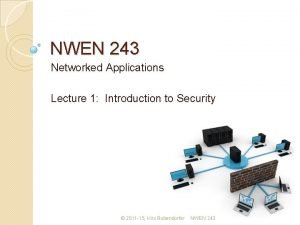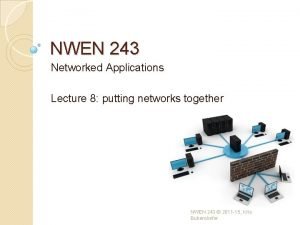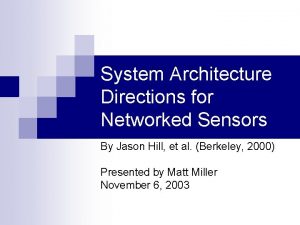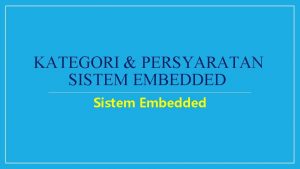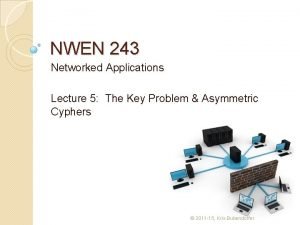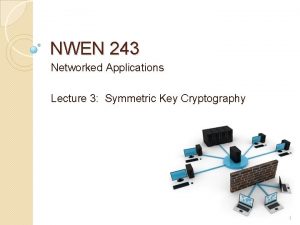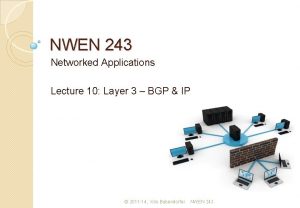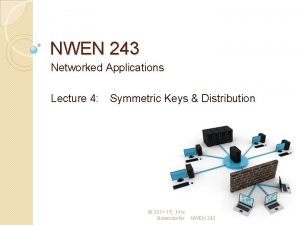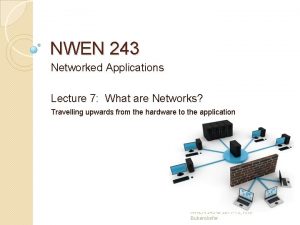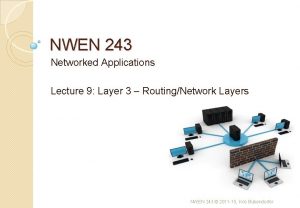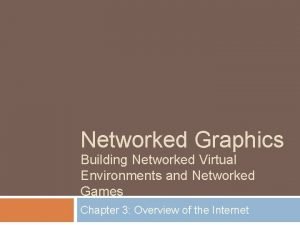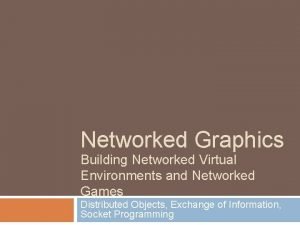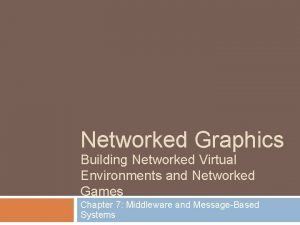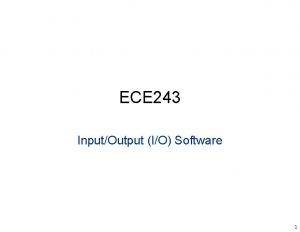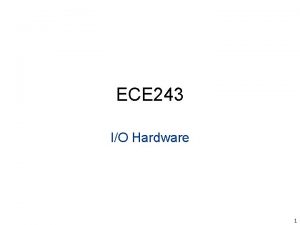NWEN 243 Networked Applications Lecture 1 Introduction to


















![Basic Cryptography: Terminology ◦ Plaintext ◦ Ciphertext [Figure 2. 01 – Plaintext Sample] ◦ Basic Cryptography: Terminology ◦ Plaintext ◦ Ciphertext [Figure 2. 01 – Plaintext Sample] ◦](https://slidetodoc.com/presentation_image_h/21ea09e2829d428f7e339a40a71f3477/image-19.jpg)




- Slides: 23

NWEN 243 Networked Applications Lecture 1: Introduction to Security © 2011 -15, Kris Bubendorfer NWEN 243

Introducing the Course �NWEN 243: Networked Applications �Modern application are rarely standalone. ◦ ◦ They communicate, they coordinate, they authenticate, and users participate (user generated content (web 2. 0) ◦ Networking is everywhere �This course looks at how we build networks, and the applications that use them. �Designed as a first Networking course, with an application focus. © 2011 -15, Kris Bubendorfer NWEN 243

What you will do in NWEN 243 � The Lecture Course: 1. Security, Public Key Cryptography, Authentication and Digital Signatures. 2. Introduction to Networking, Lans, Protocols, the protocol Stack, TCP/IP and the socket API 3. Models of Networked Applications and application layer case studies: Domain Name System (DNS) and Hypertext Transport Protocol (HTTP) 4. XML and Android Application Development, Webservices, SOAP, REST. � NWEN 243 is an introductory course, so we’ll look at the general concepts rather than focus on the finest of details. © 2011 -15, Kris Bubendorfer NWEN 243

Textbook © 2011 -15, Kris Bubendorfer NWEN 243

Some thoughts… �A couple of definitions of a Network: ◦ A network is a number of computers connected together to share information and hardware. ◦ A network is a series of points or nodes interconnected by communication paths. Networks can interconnect with other networks and contain subnetworks. Q: What is the first thing you should consider when designing a networked © 2011 -15, Kris Bubendorfer NWEN 243

About this lecture �Steganography �Cryptography, and a little taste of �Security. The Enigma Machine © 2011 -15, Kris Bubendorfer NWEN 243

Secrecy in Communications: Steganography � Information has always been critical in commerce, warfare and romance. �Steganography: ◦ Steganos (covered) and graphein (to write). � Concealed Messages: ◦ Some of the earliest accounts of secret writing relate to warfare. ◦ In BC 480 the Greek Demaratus hid a message about an impending Persian invasion underneath the wax on a writing tablet. ◦ A little later a message was sent by Histaiaeus to encourage a rebellion in Persia. He tatooted message on a messenger’s scalp, which was then allowed to regrow. On arrival his head was shaved to reveal the message. ◦ The ancient Chinese wrote messages on fine silk, which was then scrunched into a tiny ball, covered with wax, and swallowed. © 2011 -15, Kris Bubendorfer NWEN 243

Secrecy in Communications � Secret Writing: ◦ 100 AD, Pliny the Elder detailed the use of the sap(milk) of the Thithymallus plant as invisible ink. Upon heating the ink turns brown. ◦ In the 16 th Century Giovanni Porta managed to conceal messages within an un-broken hard boiled egg using alum and vineager. ◦ Microdots, WWII © 2011 -15, Kris Bubendorfer NWEN 243

Steganography, but… �The problem with steganography is that if the message is intercepted – then the contents of the message are immediately revealed. �So, ‘cryptography’ was developed in parallel: ◦ Kryptos (hidden) ◦ However, the aim is not to hide the message, but rather to hide its meaning. ◦ The sender scambles a message using a agreed protocol, and then the reciever unscrambles the message with the same protocol. © 2011 -15, Kris Bubendorfer NWEN 243

Cryptography �Two main approaches: ◦ Transposition: create an anagram of the message (the letters retain their identity). ◦ Substitution: replace each letter with an alternative (the letters retain their position). © 2011 -15, Kris Bubendorfer NWEN 243

Origins of Cyrptography 1900 BC � The first documented use of written cryptography was in the tomb of Khnumhotep (Bruce), an Egyptian nobleman of about 1900 BC, in Menet Khufu, which borders the Nile. � In the tomb the scribe used a simple code of hieroglyphic substitution, changing one symbol for another, less well-known one. However, this scribe did not use a comprehensive system of encryption; he just substituted hieroglyphs here and there, mostly at the end of his document. © 2011 -15, Kris Bubendorfer NWEN 243

Origins of Cyrptography 1500 BC �The first recorded commercial use of cryptography was in 1500 BC in Mesopotamia with an encrypted formula for pottery glaze. � The tablet containing the formula was only 3 x 2 inches and was found on the banks of the Tigris river. © 2011 -15, Kris Bubendorfer NWEN 243

Tablet in cuneiform* � Earliest known formula for pottery glazes. � Uses cuneiform signs in their least common syllabic values to attempt to hide the secrets of the formulae. � Like George Bernard Shaw's rewriting of fish as "ghoti" � *cuneiform 1 : having the shape of a wedge 2 : composed of or written in wedge-shaped characters <cuneiform syllabary> © 2011 -15, Kris Bubendorfer NWEN 243

The Cyphers - 500 BC �The Spartans developed the first military cryptograpic device around 487 BC �A strip of papyrus or leather or parchment is wrapped around a staff of wood. ◦ The secret message is written on the parchment down the length of the staff; the parchment is then unwound and sent on its way (often hidden inside a belt steganography). ◦ To decode the message, a staff of the same size is required. ◦ This is a transposition Cypher. ◦ Called a Skytale or Scytale. © 2011 -15, Kris Bubendorfer NWEN 243

Hebrew (ATBASH) – 500 BC � Scribes writing the book of Jeremiah used what is now known as the ATBASH cipher. � This is a very simple mechanical cypher – without the concept of a key. � Swap first for last, etc… A B C D E F G H I J K L M Z Y X W V U T S R Q P O N © 2011 -15, Kris Bubendorfer NWEN 243


The Kama-Sutra The sophisticated substitution cypher (with a key) appears in the Karma-Sutra, which was in-turn based on manuscripts from BC 400. � The Karma-Sutra is much maligned – it is not a sex manual. � It is a relationship text, and recommends that women should study 64 arts – including, cooking, dressing, languages, conjuring, chess, carpentry, book binding, and secret-writing (number 45). � One of the techniques described is to construct pairs of letters at random, and then substitute each letter with its partner. � ADHIKMORSUWYZ VXBGJCQLNEFPT alice, meet you at midnight, bob vrgmu, cuuz pqe vz cgxsgibz © 2011 -15, Kris Bubendorfer NWEN 243

Caesar Cypher The first documented use of a substitution cypher for military purposes was by Julius Caesar in the Gallic wars (BC 58). � In a caesar cypher the substitution key is formed by cyclically displacing an alphabet with respect to itself (i. e, 9). � A message, called plaintext, is enciphered by substituting for each letter the corresponding letter from the shifted alphabet. � The substitution produces a new string of letters called cyphertext. � a b c d e f g h i j k l m n o p q r s t u v w x y z j k l mn o pq r s t u v w x y z a bc d e f g h i alice, meet you at the pub, bob jurln, vnnc hxd jc cqn ydk, kxk © 2011 -15, Kris Bubendorfer NWEN 243
![Basic Cryptography Terminology Plaintext Ciphertext Figure 2 01 Plaintext Sample Basic Cryptography: Terminology ◦ Plaintext ◦ Ciphertext [Figure 2. 01 – Plaintext Sample] ◦](https://slidetodoc.com/presentation_image_h/21ea09e2829d428f7e339a40a71f3477/image-19.jpg)
Basic Cryptography: Terminology ◦ Plaintext ◦ Ciphertext [Figure 2. 01 – Plaintext Sample] ◦ Key [Figure 2. 02 – Ciphertext Sample]

Basic Cryptography: Terminology ◦ Cryptosystem ◦ Cryptographer ◦ Cryptanalyst

Basic Cryptography: Services ◦ Confidentiality ◦ Integrity ◦ Authenticity ◦ Nonrepudiation ◦ Access Control

Caesar Cypher II � The Caesar cypher outlined is relatively weak, as there are only 25 possible alphabetic shifts. � This was refined to use a more sophisticated keyword or key phrase. � The advantage over a random substation (like the Kama-Sutra pairs) is that the encoding does not need to be written down and consequently subject to capture. a b c d e f g h i j k l m n o p q r s t u v w x y z j u l i s c a e r t v w x y z b d fg h km n op q alice, meet you at the park, bob jwrls, xssh pzk jh hes bjfv, uzu © 2011 -15, Kris Bubendorfer NWEN 243

What is Security? �Concealment of information ◦ existence of data is as confidential as content ◦ the existence of the file “layoffs. doc”, still imparts information – even without reading it. �Integrity ◦ Data Integrity (Data is OK) ◦ Origin Integrity (We know who did what) � Availability © 2011 -15, Kris Bubendorfer ◦ Denial of Service NWEN 243
 Cuneiform tablet
Cuneiform tablet Nwen243
Nwen243 01:640:244 lecture notes - lecture 15: plat, idah, farad
01:640:244 lecture notes - lecture 15: plat, idah, farad Networked insurance
Networked insurance Networked and distributed operating system
Networked and distributed operating system System architecture directions for networked sensors
System architecture directions for networked sensors Unit 32 networked system security
Unit 32 networked system security Networked systems security
Networked systems security Fully networked vehicle
Fully networked vehicle Networked outdoor lighting
Networked outdoor lighting Kategori kategori embedded system
Kategori kategori embedded system Uci ics specialization
Uci ics specialization System architecture directions for networked sensors
System architecture directions for networked sensors Networked digital library of theses and dissertations ndltd
Networked digital library of theses and dissertations ndltd Networked sensor array
Networked sensor array Trama odissea in breve
Trama odissea in breve Write the expression 53 125 in logarithmic form
Write the expression 53 125 in logarithmic form Tabela kod genetyczny
Tabela kod genetyczny Article 243 zg
Article 243 zg Article 243 w of the constitution
Article 243 w of the constitution Art. 243 kpk
Art. 243 kpk Cs 243
Cs 243 Vibs histology
Vibs histology Nilai dari ³log729 adalah
Nilai dari ³log729 adalah
